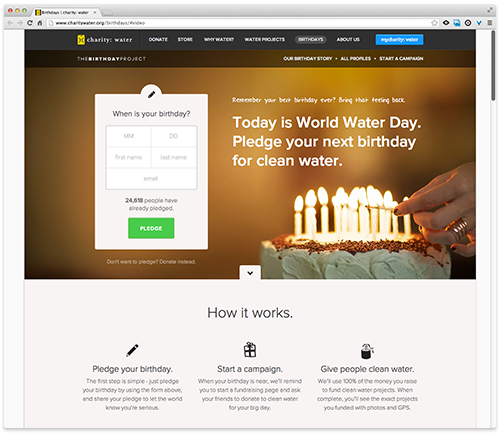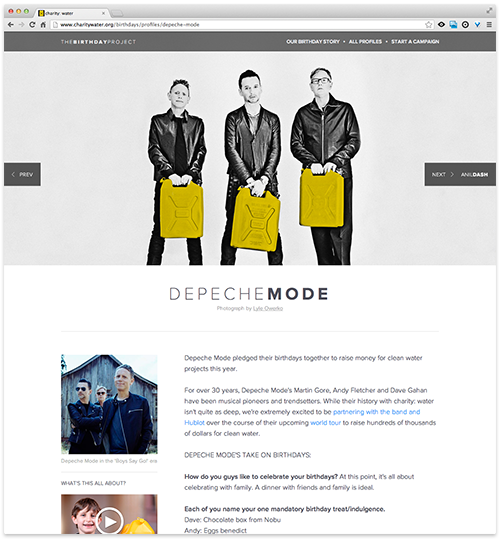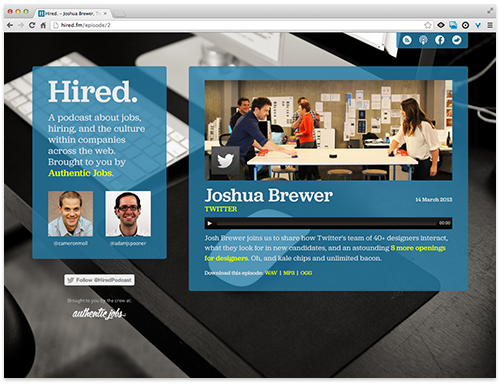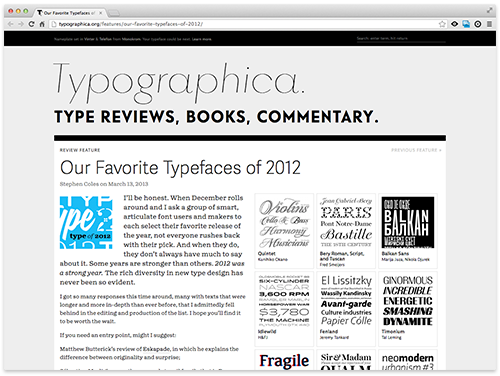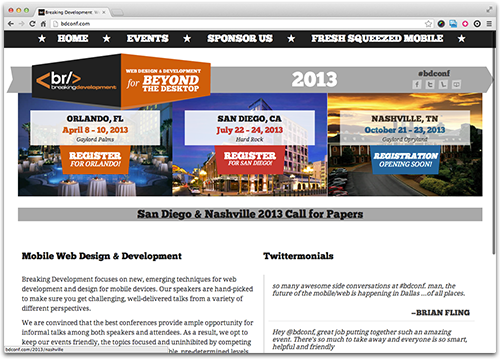Cameron Moll's Blog, page 5
May 14, 2013
“We’ve been conditioned for web apps to suck.”
Rob Foster, on web apps vs. native apps:
There is no single explanation [for why web apps generally suck]. The reason browser apps lose this fight is because of a raft of small things. It’s death by a thousand cuts.
After sharing some of those ‘cuts’ in detail, Rob lets loose with his opinion:
When an organization is making the decision not to spend developer money on building native, what they’re saying to me is that they value development costs over customer experience. I believe to do it right, you should offer your app in the way people want to use it the most. That may mean doing it browser-only, but it usually doesn’t. A business will always benefit from giving their customers a great (or insanely great) experience.
I agree pretty thoroughly with Rob’s sentiments, and I’ll tackle this issue at Breaking Development Conference in July. However, given my remarks are titled “Pitfalls and Triumphs of the Cross-Screen Experience”, I’ll also tackle the issue of integrating native apps and web apps into a cohesive, delightful user experience. (Sneak peek here.)
May 3, 2013
Nine Patterns Among Virtuoso UX Teams
The above slide deck is from my keynote presentation at Future Insights Live 2013 in Las Vegas, given earlier this week. (Access it here if it’s not showing.)
Creating and managing teams that iterate, build, and ship quality projects is one of the most challenging things to master in our industry. And to ship quickly and consistently? Even more challenging.
This presentation presents nine patterns that I’ve found common among great UX teams. I draw on interviews with teams at the likes of Twitter and Kickstarter, as well as my own background running Authentic Jobs.
I’ll be publishing a written version soonly, as it’s tough to understand each pattern without the context of my spoken remarks.
Side note: Speaker Deck is pretty fantastic. Browse a couple other recent presentations of mine here.
A Week with Google Glass
Almost a week ago I picked up my Glass explorer edition on Google’s campus in Mountain View. Since then I’ve it put into real-world use in a variety of places. I wore the device in three different airports, busy city streets, several restaurants, a secure federal building, and even a casino floor in Las Vegas. My goal was to try out Glass in as many different situations as possible to see how I would or could use the device.
A couple nights ago, I sat across the table from Luke at dinner (and later caught a pretty amazing show with him, Kristina, and Brad). He had his Glass in Vegas, and he rattled off some of the pros & cons he mentions in this article.
I still remain highly cautious about the actual utility of Glass, but I can appreciate Luke’s closing argument about its potential utility:
Any of these features alone could be considered magical, but together they’re a vision of the future.
Follow the project here.
April 24, 2013
“We’ve been hoodwinked into a trap of technological dependency.”
One of the problems with the prevalence of solutions is it overvalues invention and undervalues behavior. We look for a gizmo, when changing how we act can have the desired effect. It seems like we’ve been hoodwinked into a trap of technological dependency.
But, technology is only as good or bad as what we use it to do, and I don’t think anyone who works in tech gets into the field with malice as their intent. In fact, usually the opposite, which is why I like this business. Hell, I’m one of the the folks in technology, so none of this criticism excludes me—I only suggest we stop looking at technology as the primary way to fix problems, and stop turning a blind eye to its negative consequences and to the new problems it produces.
Author Neil Postman argued the same more than 20 years when his book, Technopoly: The Surrender of Culture to Technology, was first published:
Most people believe that technology is a staunch friend. There are two reasons for this. First, technology is a friend. It makes life easier, cleaner, and longer. Can anyone ask more of a friend? Second, because of its lengthy, intimate, and inevitable relationship with culture, technology does not invite a close examination of its own consequences. It is the kind of friend that asks for trust and obedience, which most people are inclined to give because its gifts are truly bountiful.
But, of course, there is a dark side to this friend…. Every technology is both a burden and a blessing; not either-or, but this-and-that. Nothing could be more obvious, of course, especially to those who have given more than two minutes of thought to the matter. Nonetheless, we are surrounded by throngs of zealous Theuths, one-eyed prophets who see only what new technologies can do and are incapable of imagining what they will undo.
I first read Neil’s words nearly five years ago, and they’ve stuck with me ever since. I’ve found cognizance and respect of technology’s power—the good and the bad, for better or for worse—serves to bridle my appetite for it. For example, scan my Twitter timeline and you’ll be pressed to find a single tweet on any given Sunday from the past seven years. That’s my day of rest from technology (to the extent possible), and it’s a weekly opportunity to assess my dependency on it.
But much like Frank, I’m thrilled to be part of a community that embraces technology in such fascinating ways. We’re fighting the good fight together, and I’m thrilled we’re in this together.
Coincidentally, I’ll be speaking on this very subject in the closing keynote at HybridConf later this year.
April 9, 2013
In Defense of the Floppy Disk
Those who believe that the floppy cannot represent saving a document because nobody uses real floppy disks anymore miss an important point: while symbols initially piggyback on the meaning we assigned to a material object in order to stand in for something more abstract, once a symbol is used often enough, the symbol itself is enough to carry meaning, and the material object is no longer important.
I attempted to respond to the original discussion on Branch, but I gave up. I couldn’t phrase my opinion—nearly identical to the one quoted above—as well as Connor has articulated his.
/via @dstorey
March 27, 2013
Constraint Engenders Creativity
Seasoned designers know that constraint engenders creativity, rather than inhibit it. Following is one example. There are countless more.
In my research for an upcoming presentation, I stumbled on an account describing the evolution of the iconic Coca-Cola glass bottle. In the early part of the 20th century, the Coca-Cola Company was confronting an influx of copycat beverages.
In defense of the brand, the company issued a call for design entries with one unique requirement: That the bottle, and therefore the brand, could be recognized in the dark.
As retold by The Coca-Cola Company,
The Company … decided to create a distinctive bottle shape to assure people they were actually getting a real Coca-Cola. The Root Glass Company of Terre Haute, Indiana, won a contest to design a bottle that could be recognized in the dark. In 1916, they began manufacturing the famous contour bottle. The contour bottle, which remains the signature shape of Coca-Cola today, was chosen for its attractive appearance, original design and the fact that, even in the dark, you could identify the genuine article.
Today the glass contour bottle is one of the world’s most recognized designs, and it came about in large part because of constraints imposed on the bottle’s designers.
But that wasn’t the only constraint. The Root Glass Company and designer Earl Dean imposed a constraint of their own: Base the design on nature.
Wikipedia explains:
Chapman J. Root, president of the Root Glass Company of Terre Haute, Indiana, turned the project over to members of his supervisory staff, including company auditor T. Clyde Edwards, plant superintendent Alexander Samuelsson, and Earl R. Dean, bottle designer and supervisor of the bottle molding room. Root and his subordinates decided to base the bottle’s design on one of the soda’s two ingredients, the coca leaf or the kola nut, but were unaware of what either ingredient looked like. Dean and Edwards went to the Emeline Fairbanks Memorial Library and were unable to find any information about coca or kola. Instead, Dean was inspired by a picture of the gourd-shaped cocoa pod in the Encyclopædia Britannica. Dean made a rough sketch of the pod and returned to the plant to show Root. He explained to Root how he could transform the shape of the pod into a bottle. Root gave Dean his approval.
File this under Did Not Know But Thrilled To Have Stumbled On It.
March 22, 2013
Today is World Water Day.
Water World Day is a United Nations-sanctioned day for “focusing attention on the importance of freshwater and advocating for the sustainable management of freshwater resources.”
It shouldn’t come as a surprise that I’m asking you to help me celebrate today, March 22, by donating to charity: water. There are other ways to celebrate, but in terms of trackable, meaningful contributions, I can’t think of a better way to deliver freshwater to those in need than through charity: water.
You might even consider donating your birthday, which is a fantastic way to encourage others to help you provide clean, safe drinking water. The team at charity: water unveiled a new design today for the site today, and it’s crazy easy to pledge. It doesn’t matter if your birthday is tomorrow or ten months from now. Register and they’ll notify you when the time is right.
When Suzanne and I returned home from last year’s trip to Ethiopia, we had an entirely new appreciation for the convenience of clean water. Browsing the internets this morning, I stumbled on this video by Michele Guieu, who cleverly demonstrates the privilege of clean water enjoyed by so many of us around the world:
Join me once again in making a meaningful difference in the world. Even $1 is the equivalent of nearly two meals in Ethiopia. So imagine what $1 worth of clean water production can do to change a village, a child, a life every bit as valuable as yours.
March 14, 2013
Hired, a podcast about jobs, hiring, and company culture.
Hired is a new podcast about jobs, hiring, and the culture within companies across the web. You’ll hear my voice each episode, along that of my co-host, Adam Spooner.
Episode #2 features Josh Brewer, principal designer at Twitter. We discuss how a team of 40+ designers interact, what they look for in new candidates, and kale chips and unlimited bacon. (Nom.)
For me, it’s a bit different being on the other end of the mic asking questions rather than responding to them, having done a number of podcast recordings as an interviewee. It’s a lot of fun sitting in the host’s chair, but I’m finding it takes practice to drive the conversation and ask follow-up questions. I’ll improve over time, I’m sure. But bear with my scant awkwardness in the meantime.
See also episode #1 with Charles Adler of Kickstarter.
Typographica: Our Favorite Typefaces of 2012
I’m honored to be included in Stephen Coles’ annual compendium of new typefaces for the year. Not as a type designer, but as type user. My selection was Hoefler & Frere-Jones’ Idlewild, a beautiful wide display font family.
Other notable inclusions are the layered diversity of Quintet, the roman typeface Eskapade with its “fully realized Fraktur companion”, the dually print- and screen-friendly Turnip, and more than 50 other typefaces.
See also Favorite Typefaces of 2011.
March 7, 2013
Speaking: Orlando, Las Vegas, Tampa
April 8–10: Breaking Development Conference, Orlando | @bdconf
$1,195
Pitfalls & Triumphs of the Cross-Screen Experience
Together we’ll examine what’s required to present a consistent, delightful experience to users regardless of where the experience begins, continues, and ends.
April 29 – May 2: Future Insights Live, Las Vegas | @Future_Insights
$995 (early bird special ends March 15)
Crafting Virtuoso UX Teams
I’ll share several patterns that are common among great user experience teams, as well as successful prototyping tools, hiring methods, the importance of establishing a strong team culture, and more.
June 21–22: Front-End Conf, Tampa | @frontendconf
$149
Authentic Design
Details forthcoming. But pretty much like the topic says.
Cameron Moll's Blog
- Cameron Moll's profile
- 4 followers


